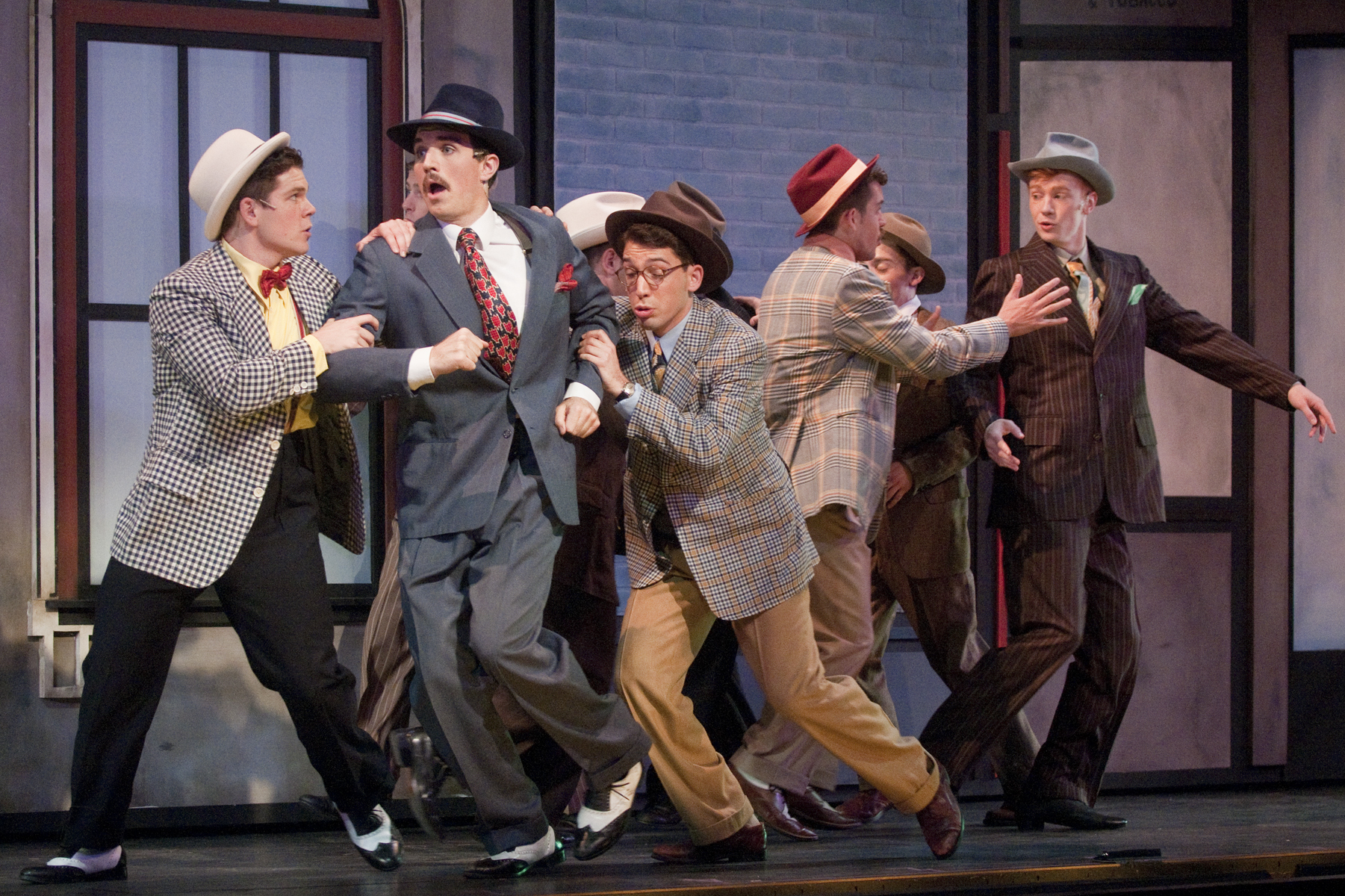UCLA Freud Playhouse to show ‘Guys and Dolls’

UCLA’s School of Theater, Film and Television brings the classic musical comedy “Guys and Dolls,” a play focused around a high-profile dice game, to the Freud Playhouse. The play is set in 1946 New York, where gambling and promiscuous behavior are frequent.
(Miriam Bribiesca/Daily Bruin)
By Yazmine Mihojevich
May 21, 2014 12:05 a.m.
The original version of this article contained an error and has been changed. See the bottom of the article for additional information.
As the dark of evening settles across a bright skyline, suddenly dice roll, showgirls sparkle and the underground world of crime, promiscuity and shady deals comes to life.
This is 1946 New York City,where a diverse range of characters deal, dance, pray and even fall in love in the annual musical production of “Guys and Dolls.”
UCLA’s School of Theater, Film and Television brings the classic musical comedy to the Freud Playhouse from May 22-24 and May 27-31. From the covert world of criminals to a New York mission and across seas to Havana, Cuba, the show follows showgirls, gangsters, missionaries and gamblers whose fates are all united in the ultimate game of chance.
In order to obtain the funds necessary to secure the location of a high-profile dice game, gambler Nathan Detroit bets another gambler, Sky Masterson, on an outlandish proposal. Masterson must convince Sarah Brown, a New York missionary, to have dinner with him in Havana. If Sarah agrees, it can mean securing the heap of sinners necessary to save her mission.
In addition, the showgirl Miss Adelaide is plagued with a constant cold that forms as a result of her 14-year engagement to Nathan, who is not committed to her. Along with a no-nonsense head missionary, gangsters, gamblers and various other characters, the classic musical “Guys and Dolls” tells a story of chance, love and friendship amid the hustle and bustle of late-1940s New York City.
“I think that the reason the show is so timeless,aside from the great music and the funny dialogue,is that those themes of love and compassion and friendship and fun still apply so much today,” said Coby Getzug, a third-year musical theater student who playsa gangster named Benny Southstreet.
In order to refresh the classic with an original touch, Linda Kearns, the production’s director and an adjunct assistant professor, said she moved theplay’stime period from the1950s back into the late 1940s.
“Everything is just so specific, down to the accuracy of not only the time period but the specific year,” said Katheryne Penny, a third-year musical theater student whoplays General Cartwright, the leading missionary.
Kearns said she partly decided on having the musical take place specifically in the year 1946 because such a date was post-Nuremberg. As such, it marked a progression out of the austerity of previous years. Besides this historical association, Kearns said the move was largely based on the desired visuals of the time period in terms of costume and design.
In playing a character that carries her showgirl persona on and off stage, Jane Papageorge, a fourth-year musical theater student who plays the lead role of Miss Adelaide, said she has a grand total of eight handmade costumes. While one of these costumes is covered in huge heart appliques another is accompanied by cheetah-print shoes, gloves and a hat.
“They just are so period and so outlandish,” Papageorge said.
What creates this period look relates directly to the buttoned-up etiquette of the time, Papageorge said. This etiquette required both men and women to never leave their home without various articles of clothing.The finished products of these garbs ultimately reflect the amount of research put into the period by the show’s costume designer.
“Our costume designer has been working so hard,” Penny said. “It’s really nice to just put on a costume and know how much information you are putting on yourself.”
The 1940s-era New York set design also has a greater purpose as a tool of juxtaposition. With buildings towering him, Getzug said he gets the sense that everyone is crowded and everyone is just trying to find his or her way.
Kearns said she wanted to point out not only the comedic elements within “Guys and Dolls,” but also the darkness of New York, a city often filled with the likes of gamblers, con men and drunks, in contrast to the mission.
Papageorge said director Kearns also had students educate themselves on the time period by reading theDamon Runyon stories the musical is based off of and watching older recordings of the musical.
Getzug said watching old gangster movies helped him better portray the physicality of his character in terms of posture and the Brooklyn accent.
“We are really going for the period style in our mannerisms, the way we speak and in the way we interact with other characters,” Papageorge said.
With a high level of attention being paid to period characters, set and costume design, Kearns said she hopes her students and youthful audience members gain greater familiarity with these nuggets of musical theater and are drawn to the musical.
“I’d love to see people appreciate these older musicals, listen to the music and just revel in it, and not think of it as old fashioned but as a period piece,” Kearns said. “The people in (“Guys and Dolls”) are the same as people in our lives now: We’re just getting a slice of life in a different time period.”
Correction: One of Papageorge’s costumes has heart appliques and another has cheetah-print shoes, gloves and a hat.


